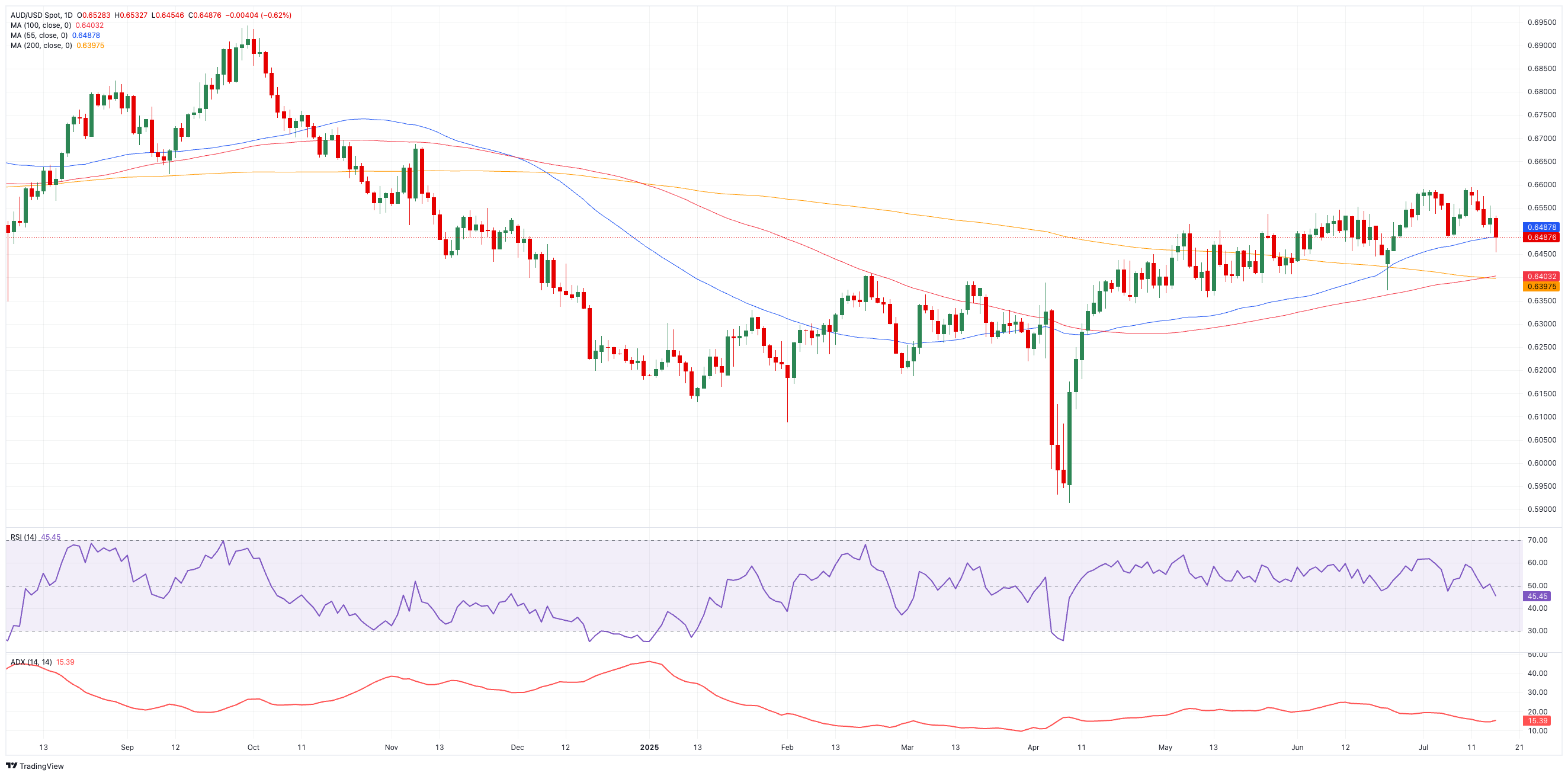
- AUD/USD resumed its decline and revisited the 0.6450 zone on Thursday.
- The US Dollar refocused on the upside, propped up by solid US data releases.
- The Australian labour market report cooled further in June.
The Australian Dollar (AUD) quickly reversed Wednesday’s optimism vs. the US Dollar (USD), sending AUD/USD back below the key 0.6500 mark and hitting new three-week lows on Thursday.
Adding to the sour mood around the Australian currency, the domestic jobs report failed to ignite some euphoria after the Unemployment Rate rose to 4.3%, the Employment Change increased by a meagre 2K people, and the Participation Rate rose a tad to 67.1%. Other data saw Consumer Inflation Expectations ease to 4.7% in July (from 5.0%).
RBA’s tightrope act
Earlier this month, the Reserve Bank of Australia (RBA) bucked expectations by holding its cash rate at 3.85%. While a majority of six board members favoured keeping rates steady, three dissented, calling for an immediate 25-basis-point cut. In a split, Governor Michele Bullock attributed more to “timing, not direction.”
Bullock has since indicated that if Q2 inflation prints close to forecasts, rate cuts will follow.
Futures markets have run with that cue, now pricing in roughly a 90% chance of an August easing, even as they nudge the likely terminal rate up from 2.85% to around 3.10%.
China’s uneven bounce
Data out of Australia’s biggest trading partner painted a picture of cautious progress. Q2 GDP grew 1.1% vs. the prior quarter and 5.2% on a yearly basis, roughly in line with Beijing’s 5% annual goal.
Furthermore, while Industrial Production continues to improve, rising 6.8% from a year ago, the growth of Retail Sales has slowed to 4.8%, indicating persistent challenges from high savings and increasing consumer debt. A $114.8 billion trade surplus in June rounded out the mixed bag, suggesting China’s economy is steady but hardly roaring.
Central banks on diverging paths?
Globally, policymakers seem to be at a fork
The RBA’s pause mirrors the Fed’s decision in June, yet Fed chair Jerome Powell has warned that US tariffs could reignite price pressures, signalling a potential split if either side sees another inflation spike. June’s uptick in US inflation only underlines that risk.
Speculators take aim
Short bets on the Aussie are mounting. CFTC data for the week to July 8 show net shorts climbing to two-week highs around 74.3 K contracts, while open interest swelled to nearly 153.4 K, marking a fourth consecutive weekly rise.
On the charts
Before aiming for the November 2024 high at 0.6687 and the psychologically charged 0.7000 level, the AUD/USD must overcome its 2025 peak of 0.6590 (June 30). B
Southwards, the July base of 0.6454 (July 17) offers initial support, ahead of the 200‑day SMA at 0.6401.
Momentum indicators are split: the Relative Strength Index (RSI) drops to around 45, while an Average Directional Index (ADX) around 16 suggests the current move lacks strong conviction.
AUD/USD daily chart

To sum up
With China’s rebound uneven and both Beijing and Washington hinting at fresh trade tensions, the Aussie may remain boxed in until a clear catalyst emerges. For now, the RBA appears inclined to tiptoe rather than sprint, signalling that any cuts are likely to be measured, not dramatic.
Employment FAQs
Labor market conditions are a key element to assess the health of an economy and thus a key driver for currency valuation. High employment, or low unemployment, has positive implications for consumer spending and thus economic growth, boosting the value of the local currency. Moreover, a very tight labor market – a situation in which there is a shortage of workers to fill open positions – can also have implications on inflation levels and thus monetary policy as low labor supply and high demand leads to higher wages.
The pace at which salaries are growing in an economy is key for policymakers. High wage growth means that households have more money to spend, usually leading to price increases in consumer goods. In contrast to more volatile sources of inflation such as energy prices, wage growth is seen as a key component of underlying and persisting inflation as salary increases are unlikely to be undone. Central banks around the world pay close attention to wage growth data when deciding on monetary policy.
The weight that each central bank assigns to labor market conditions depends on its objectives. Some central banks explicitly have mandates related to the labor market beyond controlling inflation levels. The US Federal Reserve (Fed), for example, has the dual mandate of promoting maximum employment and stable prices. Meanwhile, the European Central Bank’s (ECB) sole mandate is to keep inflation under control. Still, and despite whatever mandates they have, labor market conditions are an important factor for policymakers given its significance as a gauge of the health of the economy and their direct relationship to inflation.
Information on these pages contains forward-looking statements that involve risks and uncertainties. Markets and instruments profiled on this page are for informational purposes only and should not in any way come across as a recommendation to buy or sell in these assets. You should do your own thorough research before making any investment decisions. FXStreet does not in any way guarantee that this information is free from mistakes, errors, or material misstatements. It also does not guarantee that this information is of a timely nature. Investing in Open Markets involves a great deal of risk, including the loss of all or a portion of your investment, as well as emotional distress. All risks, losses and costs associated with investing, including total loss of principal, are your responsibility. The views and opinions expressed in this article are those of the authors and do not necessarily reflect the official policy or position of FXStreet nor its advertisers. The author will not be held responsible for information that is found at the end of links posted on this page.
If not otherwise explicitly mentioned in the body of the article, at the time of writing, the author has no position in any stock mentioned in this article and no business relationship with any company mentioned. The author has not received compensation for writing this article, other than from FXStreet.
FXStreet and the author do not provide personalized recommendations. The author makes no representations as to the accuracy, completeness, or suitability of this information. FXStreet and the author will not be liable for any errors, omissions or any losses, injuries or damages arising from this information and its display or use. Errors and omissions excepted.
The author and FXStreet are not registered investment advisors and nothing in this article is intended to be investment advice.








